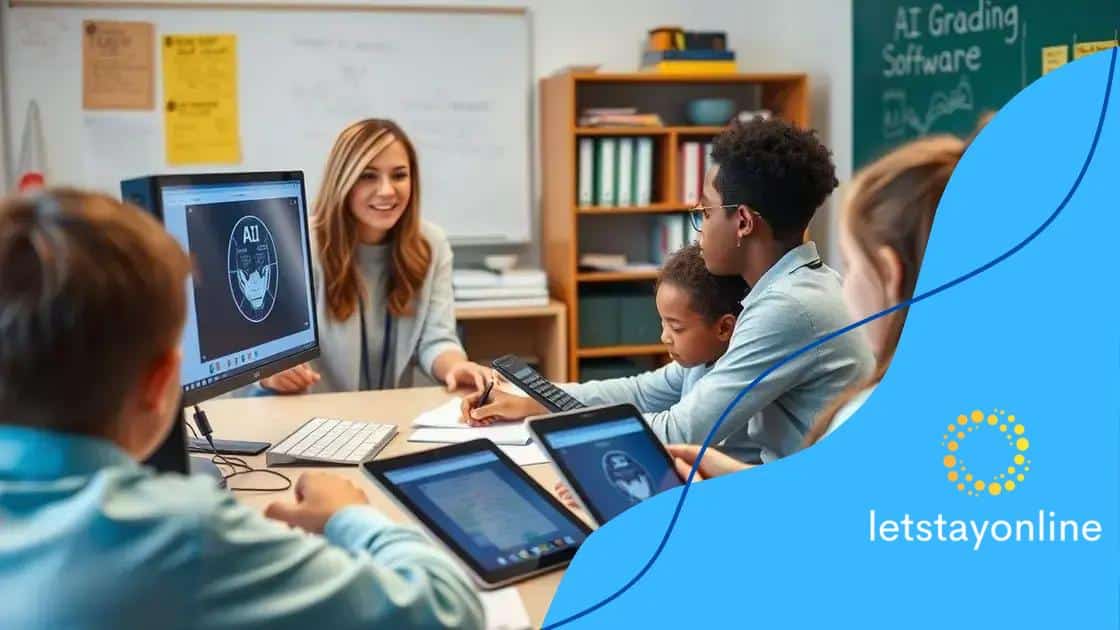How AI is assisting teachers with grading tasks

AI is assisting teachers with grading by automating tasks, providing personalized learning experiences, and offering real-time feedback, thus enhancing efficiency and enriching the educational process.
How AI is assisting teachers with grading has been a game-changer in education. Imagine having more time to engage with students while letting technology handle the grading grind. Intrigued? Let’s dive into how this is happening.
The role of AI in education
The role of AI in education has grown significantly in recent years. With technology evolving rapidly, educators now have powerful tools at their disposal to enhance the learning experience.
What is AI in Education?
AI in education refers to using artificial intelligence technologies to support teaching and learning. These innovations range from smart tutoring systems to automated grading solutions that can make education more efficient and personalized.
Benefits of AI for Educators
One of the key advantages is the ability to analyze vast amounts of data quickly. This helps teachers gain insights into student performance and identify those who may need additional support. Some benefits include:
- Time-saving: Automation of repetitive tasks, like grading.
- Personalized learning: Tailoring lessons to meet individual student needs.
- Enhanced engagement: Interactive tools that boost student interest.
- Data analysis: Making sense of performance data easily.
This technology can adapt to different learning styles, allowing students to progress at their own pace. For instance, a student struggling with math can benefit from a personalized program that adjusts difficulties based on their responses.
AI Tools in the Classroom
Several tools incorporate AI to support teachers. For example, grading software can analyze written assignments and provide feedback, freeing up valuable time for instructors to focus on direct student interaction.
Additionally, AI-driven platforms can offer quizzes and assessments that adjust to a student’s skill level, creating a more tailored educational experience. This not only enhances learning outcomes but also allows teachers to identify trends and areas needing improvement.
Future Prospects
As AI continues to advance, its role in education will likely expand further. We can expect more innovative tools that will enhance the teaching process, making it more efficient and effective. However, while AI can provide substantial benefits, it’s crucial for educators to balance technology with human interaction to foster a nurturing learning environment.
By leveraging AI, teachers can enhance their effectiveness and create a more engaging atmosphere for students. The future of education holds endless possibilities, with AI leading the way to innovative solutions.
How AI tools are enhancing grading efficiency

How AI tools are enhancing grading efficiency is changing the landscape for teachers everywhere. With these innovative technologies, instructors find it easier to manage their workload and provide timely feedback to students.
Automated Grading Systems
One notable advancement in grading is the emergence of automated grading systems. These tools can quickly evaluate assignments, reducing the time teachers spend on grading. For example, essays and multiple-choice tests can be scored in seconds, allowing educators to focus more on teaching.
Enhanced Feedback Mechanisms
In addition to saving time, AI helps improve the quality of feedback students receive. By utilizing detailed algorithms, these systems can pinpoint specific areas where a student may struggle. This insight allows teachers to provide targeted support, helping students learn effectively.
Moreover, AI tools can generate comprehensive reports on student performance over time. These analytics can reveal trends that guide instructional strategies and curriculum adjustments. For instance, a teacher could discover that a class excels in one area but needs help in another. With this knowledge, they can adjust lessons to meet student needs better.
Reducing Bias in Grading
Another significant advantage is the potential for AI to minimize biases that may affect grading. Traditional grading methods can sometimes be influenced by subjective factors. However, automated systems focus on objective criteria, ensuring a more consistent and fair evaluation process.
Teachers can rely on these tools to provide standardized grading experiences, leading to a level playing field for all students. This fairness fosters an encouraging learning environment where every student feels valued based on their performance.
Integrating AI into the Curriculum
As schools continue to adopt these AI tools, integrating them into everyday classroom activities becomes essential. Training educators on how to utilize these systems effectively is crucial for maximizing their benefits. Workshops and professional development sessions can prepare teachers to leverage technology in their grading practices.
Ultimately, the goal is to enhance the educational experience for both teachers and students. With AI leading the way, grading can be more efficient, allowing educators to devote more time to nurturing their students’ intellectual growth.
Benefits for teachers using AI solutions
The benefits for teachers using AI solutions are numerous and impactful. These technologies offer teachers innovative ways to streamline their tasks, enhance productivity, and improve student outcomes.
Time Efficiency
One significant advantage is the time saved in administrative tasks. AI can automate grading and attendance tracking, which frees up educators to spend more time on lesson planning and student engagement. This efficiency allows teachers to focus on what they do best: teaching.
Personalized Learning
Another benefit is the ability to create personalized learning experiences for students. Through AI, teachers can tailor lessons and resources to meet the individual needs of each student. For example, educational platforms can analyze student performance and suggest specific exercises that target areas for improvement.
- Adaptive assessments: Tools can adjust the difficulty of questions based on the student’s performance.
- Targeted resources: Providing materials that align with a student’s learning style.
- Immediate feedback: Allowing students to learn from mistakes right away.
This customization helps learners feel more engaged and supported, ultimately leading to better academic performance.
Improved Communication
AI solutions also enhance communication between teachers, students, and parents. AI-powered tools can facilitate messaging, ensuring everyone stays informed about academic progress and classroom activities. Teachers can set up automated communications that remind parents of upcoming events or share student accomplishments, fostering a stronger school community.
Moreover, these solutions provide a platform for collaboration. Teachers can easily share resources and strategies with peers, creating a network of support and growth among educators.
Data-Driven Insights
With the help of AI, teachers can access valuable data that informs their instructional practices. By analyzing trends in student performance, teachers can adjust their methods to better align with student needs. This data-driven approach enables educators to pinpoint what works and what doesn’t in their teaching.
As schools continue to embrace these technologies, the landscape of education will change for the better. The integration of AI solutions not only benefits teachers but also cultivates a more enriching learning experience for students.
Real-life examples of AI in grading

Real-life examples of AI in grading showcase how technology is revolutionizing education. Many schools and educational institutions are now using AI tools to streamline their grading processes effectively.
Automated Essay Scoring
A notable example is automated essay scoring systems. These tools assess student essays using natural language processing to evaluate writing quality. Systems like Grammarly and Turnitin not only check for grammar and punctuation but also provide feedback on structure and content quality. This allows teachers to focus on providing more constructive feedback instead of spending hours grading.
AI for Assessing Multiple-Choice Tests
Another real-world application is the grading of multiple-choice tests. AI can quickly scan and score large volumes of tests accurately. For instance, tools like ZipGrade allow teachers to capture student answer sheets with a mobile app. The app uses AI technology to grade the tests in seconds and provide instant results.
- Time-saving: Grading can be completed in minutes instead of hours.
- Immediate feedback: Students receive scores and performance insights right away.
- Data tracking: Educators can track performance trends and patterns over time.
This immediate and detailed feedback enables educators to adjust their teaching strategies according to student needs.
AI-Driven Learning Platforms
AI-driven learning platforms like Knewton and Smart Sparrow tailor instructional content based on individual student performance. These systems analyze how well students are grasping concepts and adjust the materials accordingly. For example, if a student struggles with a particular topic, the system offers additional resources and exercises to help them improve. Teachers can review analytics on student comprehension, allowing for customized assistance.
These innovative uses of AI in grading enhance the educational experience both for students and teachers. By alleviating the burden of manual grading, educators can dedicate more time to lesson planning, student interaction, and other critical teaching activities.
Future trends of AI in education
The future trends of AI in education are exciting and full of potential. As technology continues to advance, educators and students can expect significant changes in various aspects of learning and teaching.
Increased Personalization
One of the key trends is the move towards even more personalized learning experiences. AI will enable adaptive learning systems to analyze individual student data better, providing tailored educational resources that meet specific needs. For example, students who struggle with math can receive targeted exercises that focus on their weaknesses.
Enhanced Learning Analytics
Another trend is the use of enhanced learning analytics. Schools will increasingly adopt AI to track and analyze student performance data. This information allows educators to gain insights into learning patterns and improve teaching strategies. By identifying what works best for different students, teachers can create more effective lesson plans.
- Real-time feedback: Students will receive immediate feedback on their work, allowing for quick adjustments.
- Behavioral insights: AI can help identify at-risk students early, enabling timely interventions.
- Curriculum adjustments: Educators can adapt the curriculum based on performance data.
These analytics will empower teachers by guiding them to make data-driven decisions that enhance learning outcomes.
A Focus on Lifelong Learning
The future also emphasizes the importance of lifelong learning. As the job market changes rapidly, AI tools will help individuals continuously develop new skills. Online learning platforms embedded with AI will recommend courses or modules based on a learner’s career path or interests. This approach encourages adaptability and ensures learners stay relevant in their fields.
Integration of Virtual and Augmented Reality
Moreover, the integration of virtual reality (VR) and augmented reality (AR) into the educational experience will increase. AI will enhance these technologies, creating immersive learning environments that engage students in new ways. Imagine studying biology by virtually exploring the human body or history by walking through ancient civilizations.
As these innovative educational tools become more prevalent, students will have opportunities for deeper, experiential learning that traditional methods may not provide.
In summary, the future of AI in education will continue to evolve, making learning more personalized, engaging, and efficient. Teachers and students alike will benefit from these advancements, creating a more enriching educational experience.
In conclusion, AI is transforming education by making grading and teaching more efficient and effective. As we move forward, the future of education looks bright with the integration of AI tools that personalize learning, enhance communication, and provide valuable insights. Teachers can focus more on engaging with students while utilizing technology to improve learning outcomes. By embracing these changes, both educators and students will benefit from a more innovative and enriched learning environment.
FAQ – Frequently Asked Questions about AI in Education
How does AI improve grading efficiency?
AI streamlines grading by automating tasks, allowing teachers to spend more time on student engagement instead of manual grading.
What are some examples of AI tools used in education?
Examples of AI tools include automated essay scoring systems, AI-driven learning platforms, and apps for analyzing student performance.
How can AI personalize learning experiences?
AI analyzes student data to tailor educational content, making learning more effective by addressing individual strengths and weaknesses.
What is the future of AI in education?
The future includes more personalized learning, enhanced analytics for tracking performance, and the integration of virtual and augmented reality into classrooms.






